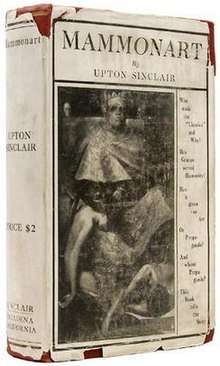Mammonart
Mammonart. An Essay on Economic Interpretation is a book of literary criticism from a Socialist point of view of the traditional "great authors" of Western and American literature (along with a few painters and composers). Mammonart was written by the prolific muckraking journalist, novelist and Socialist activist Upton Sinclair, and published in 1925.
 First edition | |
| Author | Upton Sinclair |
|---|---|
| Country | United States |
| Language | English |
| Publisher | Self (Pasadena, California) |
Publication date | 1925 |
| Media type | Print (Hardcover) |
| Pages | 390 pages |
| Preceded by | The Goslings |
| Followed by | Money Writes! |
Overview
The book is one of the "Dead Hand" series: six books Sinclair wrote on American institutions. The series also includes The Profits of Religion, The Brass Check (journalism), The Goose-step (higher education), The Goslings (elementary and high school education), and Money Writes! (literature). The term "Dead Hand" criticizes Adam Smith's concept that allowing an "invisible hand" of many people's individual self-interests to shape economic relations provides the best result for society as a whole.
Sinclair intended Mammonart to be an alternative "textbook of culture" (p. 384). He says he expected it to soon be used as a textbook in Russian high schools, and hoped that it would be adopted by other European countries after they experienced Socialist revolutions.
In each chapter, Sinclair critiques an artist according to his or her support for the rich and powerful. Most artists do not challenge the status quo and take positions such as 'art for art's sake' or 'art is entertainment.' No matter how beautiful their work, by their passivity such artists perpetuate oppression and inequality.
For example, in the chapter on Shakespeare, entitled "Phosphorence and Decay," Sinclair praises the writer's glorious facility with words; however, this great talent "saved him from thinking." In contrast, Dickens' unique contribution was to "force into aristocratic and exclusive realms of art the revolutionary notion that the poor and degraded are equally as interesting as the rich and respectable."
Mammonart is notable for Sinclair's repeated statement that all art, including his own, is propaganda. The popular distinction between propagandists like Jesus and Tolstoi, and Shakespeare and Goethe, who are "pure and unsullied creative artists ... is purely a class distinction and a class weapon..." (p. 106)
The list of artists discussed is similar, though shorter, to a 1940 list of Great Books. Sinclair also includes writers of lesser importance who were included at the time in the American literary canon.
Artists discussed:
- Homer
- Aeschylus
- Sophocles
- Euripides
- Aristophanes
- Virgil
- Horace
- Juvenal
- Boccaccio
- Dante
- Miguel de Cervantes
- Michelangelo
- Raphael
- Shakespeare
- John Milton
- John Bunyan
- John Dryden
- Pierre Corneille
- Jean Racine
- Molière
- Voltaire
- Rousseau
- Jonathan Swift
- Samuel Richardson
- Henry Fielding
- Robert Burns
- Beethoven
- Goethe
- Jane Austen
- Sir Walter Scott
- Samuel Taylor Coleridge
- Robert Southey
- William Wordsworth
- John Keats
- Honoré de Balzac
- Victor Hugo
- Théophile Gautier
- Alfred de Musset
- George Sand
- Flaubert
- Heinrich Heine
- Richard Wagner
- Thomas Carlyle
- Alfred Lord Tennyson
- Robert Browning
- Matthew Arnold
- Charles Dickens
- William Makepeace Thackeray
- John Ruskin
- William Morris
- Ralph Waldo Emerson
- Henry Wadsworth Longfellow
- John Greenleaf Whittier
- Nathaniel Hawthorne
- Edgar Allan Poe
- Walt Whitman
- Pushkin
- Gogol
- Turgenev
- Dostoievski
- Tolstoi
- Goncourt brothers
- Émile Zola
- Guy De Maupassant
- Henrik Ibsen
- Strindberg
- Nietzsche
- Emile Verhaeren
- Algernon Charles Swinburne
- Oscar Wilde
- James Abbott McNeill Whistler
- George Meredith
- Henry James
- Mrs. Humphry Ward
- Mark Twain
- William Dean Howells
- Ambrose Bierce
- Richard Harding Davis
- Stephen Crane
- Frank Norris
- David Graham Phillips
- O. Henry
- Jack London
- Anatole France
- Percy Bysshe Shelley
Mammonart was reprinted in paperback in 2003 by Simon Publications, ISBN 0-9725189-7-5.
Critical reception
Mammonart was read by undergraduates in the 1920s.
Mammonart has been mostly ignored by critics. Very few reviews are available from online scholarly databases.
Quotations
"All art is propaganda. It is universally and inescapably propaganda; sometimes unconsciously, but often deliberately, propaganda." (p. 9)
"Great art is produced when propaganda of vitality and importance is put across with technical competence in terms of the art selected." (p. 10)
On his enjoyment of John Bunyan's Pilgrims Progress, "One does not escape the need of personal morality by espousing proletarian revolution." (p. 112)
External links
- Sinclair's papers for Mammonart are at the Lilly Library, Indiana University, Bloomington, Indiana.